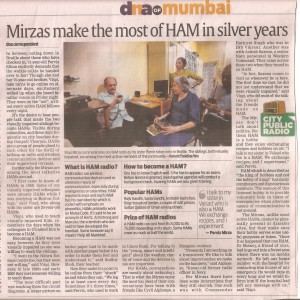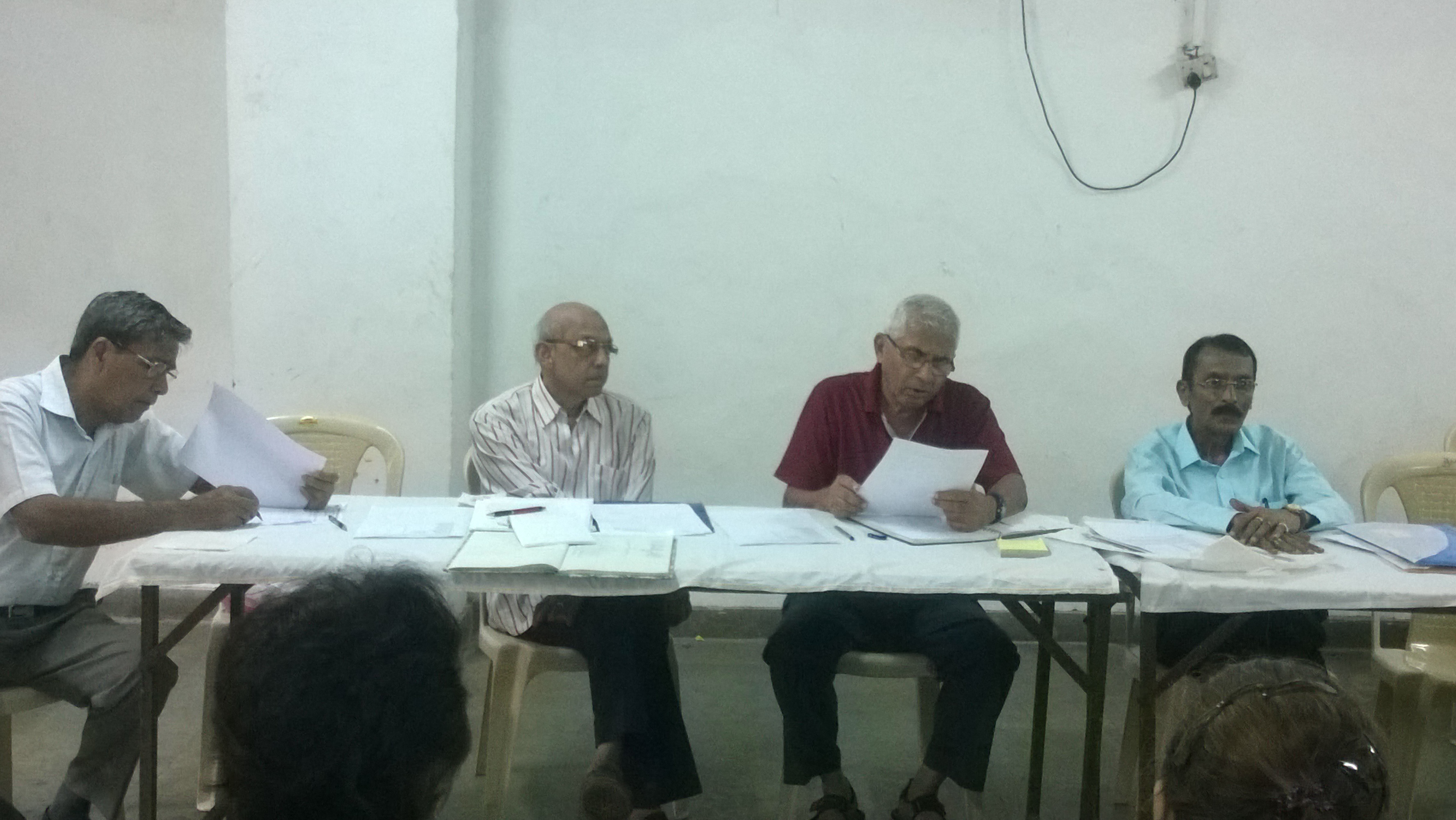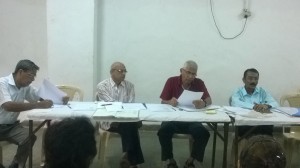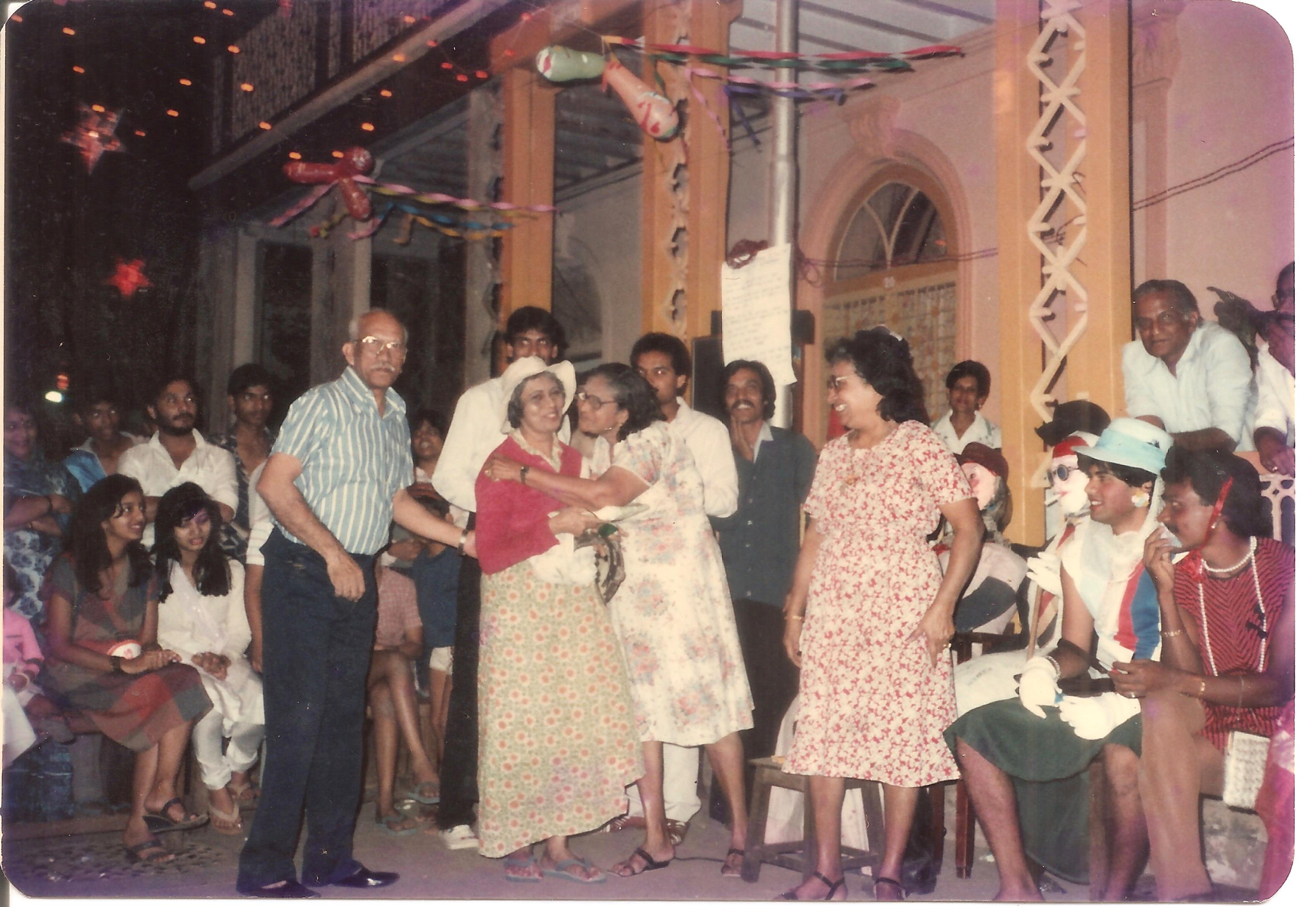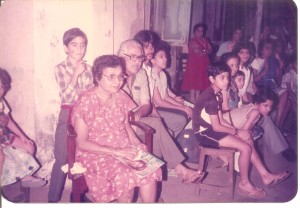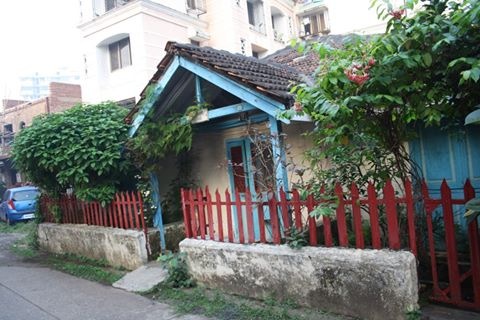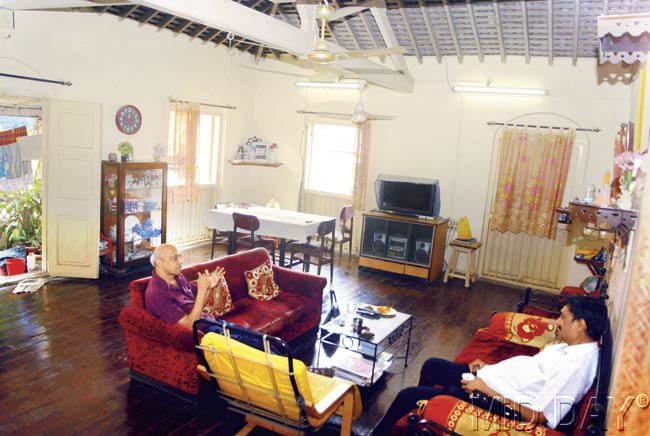Inspired by the European Heritage Days, Alliance Francaise returns for the fifth consecutive year with its Heritage Week — and the guided tours that accompany it. Rafique Baghdadi and Sancia Sequeira will guide folks on three hour long tours, focusing on different parts of the city. Baghdadi’s trails include a tour of the city’s charming Irani cafes (September 25, 9.30 am), discovering the rich history of Mazgaon (September 21, 9 am) and exploring religious sites in Byculla (September 23, 9.30 am). Sequeira conducts a tour of Bandra (September 20, 9 am), a walk through the slums of Dharavi (September 22, 9.30 am) and a look at the South Indian communities of Matunga (September 24, 9 am). Continue reading “Guided walks through Mumbai – Mumbai Mirror, 16th September 2014”
Tourists visit to Matharpacady Village from Portugal
A bus load of tourists (25-30) on a holiday to India visited our Village on Tuesday, 9th September ’14. They were staying at the Trident, at Bandra Kurla Complex and were visiting places in and around the city of Portuguese interest. They had already visited Daman & Diu, the Vasai (Bassein) Fort and now our Heritage Village before proceeding to visit Gloria Church at Byculla. Continue reading “Tourists visit to Matharpacady Village from Portugal”
Time Limit Set for Registering Documents – Times of India 15th August 2014
Continue reading “Time Limit Set for Registering Documents – Times of India 15th August 2014”
Trending Today – Mumbai Mirror, 15th August 2014
Site specific
Holy Cross Oratory
Continue reading “Trending Today – Mumbai Mirror, 15th August 2014”
Mirzas make the most of HAM in silver years
AGM – Matharpacady Residents’ Welfare Association – ALM
New Year Eve Celebrations – 1980s
So that you don’t Bungle-ow
This paper ran a two-part series on bungalows in Mumbai and how residents are still clinging on tenaciously to old, family bungalows for various reasons.

West View 15, owned by Gemma Fernandes, Gerard Fernandez and Ingrid Pinto in Bandra. Pic/Sayed Sameer Abedi
From resisting the lure of the big bucks wielding builder and redevelopment riches to dealing with threats, some residents feel high maintenance and other problems pale in comparison to the positives of living in bungalows.
Here, real estate expert and legal consultant Ameet V Mehta, takes on questions about bungalows, a fast vanishing feature in a city dominated by buildings.
The interview:
Q. Bungalows are slowly but surely vanishing off the map in Mumbai, residents who cling on to old, family bungalows are now a novelty…
A. Yes. Most of the residences are medium-sized bungalows, which are now getting dotted by high-rise buildings. As the city does not have much land available, several old bungalows are giving way to high-rise residential projects.

Ameet V Mehta
Builders and developers are buying such properties and are re-constructing high-rise buildings on them. The per sq.mt cost in this city has multiplied and it has become very challenging to keep a large pie of land in Mumbai.
Property tax has increased and bungalow owners want to encash Floor Space Index (FSI) available on their land. So they prefer to let the bungalow schemes go away and convert them into building type structures.
Q. Do bungalow owners follow rules like flat owners in buildings in co-operative Societies?
A. Yes, they have to if they are in a co-operative housing society. Eg: Juhu Scheme comprises 14 Co-op Societies of which major are plot or bungalow owners. In such a scenario, they have to follow the Co-operative Society rules. Then, there are bungalow owners who have self-regulating bungalows, which do not form part of any society.

Schubert Vaz’s bungalow in Borivali. Pic/Ronak Savla
Q. When bungalow owners are made offers by builders for redevelopment should they take them up or resist the offer?
A. It is advisable to take such offers since they can encash FSI. The norms of FSI laid out for urban areas are inflexible.
However, many semi-urban and rural areas are not bound by regulations with regard to mandatory parking and open space provision, rules pertaining to structural safety or construction regulations such as FSI. The norms within which you can construct your own bungalow will not be the same for different areas.

One of the old bungalows at Matharpacady. Pic/Shadab Khan
This mainly depends on which corporation limits the plot falls in, or if it falls under gram panchayat jurisdiction. Estimating the construction cost also plays a very important role before you take a decision on redevelopment.
The actual construction cost would mainly comprise plot rate, stamp duty amount on the plot purchased to be paid to the government, cost of the legal clearances that are obtained from different authorities, labour cost, fees to the consultant, if appointed, cost of raw material and building materials like cement, steel, bricks, tiles etc.
The material cost may differ as per the quality. Electricity and water charges, sanitary work, waterproofing, roofing, stonework, doors, windows, painting and finishing costs are the common costs involved with the construction process. Location is also considered while calculating the redevelopment cost.
Estimating the cost in advance will give you a rough idea about how much you will require for building a tall structure or in order to retain the bungalow. These are not the only factors to remember but they are certainly the key aspects which have to be carefully measured before taking a decision on demolishing a bungalow for redevelopment.
It is a wise piece of advice that you appoint any consultant or any professional who will appropriately assist with this entire process, commonly called as a feasibility report. Considering the complexities involved, it often makes sense to take an offer to construct and convert a bungalow into a building rather than construct and retain a new bungalow.
Q. What are the challenges of maintaining a bungalow in the city, compared to a flat?
A. Considering that the living space of a flat is small and each resident is supposed to keep their section clean, maintenance is easier. Since a bungalow is big compared to a flat, maintenance can be a strain. It is also expensive. An average flat may require not more than one hour to clean on a daily basis, but a bungalow may require at least four hours to clean on average. It is also much more expensive to maintain a bungalow as compared to a flat.
Q. Building society garages cannot be used for any activity like holding classes, tailoring shops etc. Can bungalow garages be used for other activities?
A. You should take an opinion of local municipal authorities to verify that the activity that you are intending to start requires municipal permission. If yes, it is better to take permission.
Q. Sometimes, bungalow owners live in one part or floor of their home, they let out the other floor or part to some tenant… is this legal?
A. Yes. Mostly such people who stay in a part of your home are called as paying guest. You can also give a part of your house on lease subject to legal and statutory compliances.
Q. Should one buy an old bungalow? What should one look out for when buying a bungalow in Mumbai?
A. Here is a list of some of the things that you should look when buying an existing bungalow:
>> Check for the structure of the bungalow. Normally, though, structures are strong.
>> Check for old plaster because it may just disintegrate into dust (airborne dust).
>> Old bungalows are not child friendly at times, (i.e. lead-based paint, asbestos flooring, steep stairs…).
>> Modern furniture does not fit through antique doorways.
>> Painting walls and trimming takes thrice as long as it does in a newer house because of all the holes/nicks/gouges you have to patch. In old bungalows, plants can grow within your old walls. No doors are standard size. Check for plumbing and electrical lines as well.
Q. Is it better to leave a home in South Mumbai to opt for a bungalow in the suburbs?
A. It is all about economics. Affordability and cost of living would play an important role in your decision.
Q. In the end, do you think bungalows will survive the next generation?
A. Eventually No! Living in a social and slightly dense surroundings plays an important role. It would sometimes be very frustrating to not have neighbours and live like a nuclear family without neighbours or have improper neighbours without social connect. Then, of course are economics and fissures in the family too play a role.
– See more at:
http://www.mid-day.com/articles/all-you-wanted-to-know-about-mumbais-bungalows/15340158#sthash.BvxVurTL.dpuf
Mid-Day – Bunga-lows and highs
Built in the 1950s in what is known as the ‘original Immaculate Conception (IC)’ colony, DX Vaz House in Borivali stands tall more than 60 years later. Talking about his bungalow, Schubert Vaz, a musician by profession says, “My father and three of his musician friends bought land in Borivali around India’s Independence, when the area was a deserted place with a large forest cover.

Dennis Baptista (L) and Percy D’Souza discuss Matharpacady’s history. Pics/Shadab Khan
This area grew to a village and is now a buzzing metro space with buildings all over. The change has left me astounded.” Vaz goes on to say, “Living in a bungalow has a charm of its own as we can avoid the bickering of neighbours, plus we have our own compound and space. I live with my wife and sons here, and within the four walls of our house, we have a little world of our own.”

DX Vaz bungalow in IC Colony has been standing for more than 50 years. Pic/Ronak Savla
Owner’s pride
As the owner of a bungalow in the posh IC Colony area, I have many people who look at me in awe. I get many ‘wows’ from people and it makes me feel nice. I have nine rooms which include my music room. As a musician, music is a vital part of my world; I share my knowledge by conducting classes for those who want to learn. I also have practice in this room. In a smaller house, things would get too crammed, having a big house proves to be a plus,” adds Vaz.
 Schubert Vaz, a musician by profession with his wife in their Borivali home. Pic/Ronak Savla
Schubert Vaz, a musician by profession with his wife in their Borivali home. Pic/Ronak Savla
The Borivali resident says he is not sure whether his children will keep the bungalow. Vaz says, “Builders have come on and off to offer me a good deal in order to build a multi-storey building here. But I have managed to put them off a number of times, I am happy with my house and the way it is. I have to shell out a lot of money for maintenance, leaks, painting work requires a lot of money, but I have never been tempted to sell.”

That’s what the Vaz family think of their home. Pic/Ronak Savla
Builder pressure
At Matharpacady in Mazgaon, Martin and Lavina Cardozo live at House No 32 on the first floor, while Martin’s younger brother’s family live on the ground floor. Living in the Grade 3 heritage area has seen the family receive numerous threats from builders for their house.

The Cardozo bungalow in Mazagoan
Lavina says, “We used to get calls on our landline from goons who claimed to be from some underworld don or the other saying that we should sell our house at the earliest. The thugs would come over at 2 am and 3 am to harass us. Now, thankfully, they have stopped. Those times were pure mental torture and for the last two years we have been able to live in our house in peace.”

Lavina and Martin Cardozo at their home
Her husband Martin adds, “My family has been living in this house for more than 50 years, Burmese wood has been used in this home. I know that the builders are seeking to get their hands on this wood that once sold will fetch a huge sum of money. Till we are alive, I will not let this house be demolished nor will I sell it.”

This chapel at Matharpakady was built when a plague killed many in the city in the 1880s
Close quarters
Residents of the area have formed the Matharpacady Residents’ Welfare Association in order to combat builder pressure as well as to deal with the government agencies in an organised manner.
Percy D’Souza one of the oldest members of this association that was started in the 1970s says, “Many of the bungalows here have been in existence for more than 100 years. St Isabel’s High School was housed in a couple of them many years ago. When Matharpacady was declared a slum by the Brihanmumbai Municipal Corportaion (BMC) we all rose up and fought for it to become a heritage village.”
Revealing how the association uses the Right to Information (RTI) Act effectively, Dennis Baptista, president of the group says, “The RTI is our only way of fighting for the right to live in our homes. Builders often come and build illegal constructions in and around the village, we use this tool to avoid letting our haven become a concrete jungle.”
Joy of living
Explaining why she and her husband continue to live in a bungalow even though they have been threatened and offered huge sums of money to shift, Lavina says, “We have everything close by — Crawford Market, Chhatrapati Shivaji Terminus, Mumbai Central stations, the top city hospitals. Everything is convenient for us. My daughter lives in Malad and commuting is cumbersome from the suburbs.”
Agreeing with his wife, Martin adds, “The life here is what I have lived all through the 70 plus years that I have existed, I cannot imagine a life away from here. Many of our neighbours have chosen to sell their bungalows and move to faraway Vasai, Virar, Thane, Panvel and some even stay in Pune, now.”
D’Souza goes on to say, “If a person lives here, he or she will never want to live anywhere else. We have spacious houses, a small world of our own here. Our neighbours are like family and friends, we literally live in each others houses, this sense of belonging and oneness is something that along with the love for our houses, helps us fight each time a builder or the government opts to offer to raze our houses and do redevelopment.”
Shelling out money
With the monsoon set to hit the city in June, many houses in Matharpacady have tile and roof repairers working on them. “Every year, I end up spending at least R 50,000 on house repairs before the monsoon so that we don’t have a leaky roof during the rains.
Varnishing the wood, painting the house and looking after the external and internal structure of the house is a costly affair, which has forced many people who used to live in this area to sell their houses to others,” says Martin Cardozo.
Praising the cross ventilation in bungalows and pointing that out as one of the top reasons why even today they live in these big houses in Mumbai, Baptista says, “Lokmanya Tilak’s close associate Joseph ‘Kaka’ Baptista was born and lived here.
This village is not just historic because of the houses that have been here for many years but also people who have been a part of India’s freedom struggle. Descendents of the great freedom fighter’s associate still live here. This area is perhaps the best ventilated part of Bombay; yes the city will always be named that in my view. We all do our bit to keep our houses in the best possible condition.”
Lavina Cardozo adds, “The water and electricity bills, taxes, etc come up to a huge sum since the house is huge. If we stayed in a flat I think we would pay a little lesser, but we would have less space. We pay the old tax rates and so if this place is redeveloped, we will have to pay more taxes.”
Standing strong
Years from now, the residents of Matharpacady are confident their village and houses will still be standing. Baptista says, “The same love that we have for our houses is what we have ensured is inculcated in our children. As much as we love our bungalows and this village, even the children and young people of Matharpacady care and are passionate about preserving this heritage. “
Agreeing with him, D’Souza says, “Seeing us fight against the government, builders and various politicians in the last few years has, in a way, made our children and youngsters more aware. When you tell friends that you live in a bungalow, their reactions are interesting.
As a child, it is exciting to be looked at in awe since you live in a huge house, I enjoyed the attention and my children also are happy to bring friends home. Seeing their joy, I know that they will fight to keep our bungalows even after us.”
Claiming that bungalows have strong structures, Martin Cardozo says, “There was a time when they claimed our house had white ants. The BMC sent some people who used saws to cut the wood. Three saws broke but the wood wasn’t cut, that is how strong it is.”
“If there is an earthquake today, I can assure you that many high rises in this area will fall but our houses will still stand. We will have enough time to take our cupboards and valuables with us,” ends Baptista.
Mirror tried – When Mazgaon was hip
By Bhairavi Jhaveri, Mumbai Mirror | May 21, 2014, 12.00 AM IST
(Clockwise from left) A typical, recently refurbished, East Indian home; The entry to Lion’s Den and Dhiresh Sharma sharing anecdotes on the tour
It’s hard to imagine that the largely uncharacteristic industrial areas of Mazgaon and Byculla were once tony neighbourhoods; home to the Byculla Turf Club and lavish parties in country houses. “So, in a sense, Mazgaon was what Bandra is today, the first hip suburb of Mumbai,” Dhiresh Sharma of Travel Logs says, interrupting my train of thought. We smirk in disbelief before spending the next three hours winding our way through Matharpacady, the first East Indian village or gaothan of Mumbai.
Our group of four travellers – heritage explorer Leora Pezarkar, Matharpacady local Hansel Baptista, Sharma and I are to take a few lefts and rights to the monotonous hammering of woodwork inside a dilapidated mansion.
And suddenly, we are standing before the defining landmark of the area – its mango trees that fruit twice a year. The numbers are down to just one, and this one bears fruit in May and October, standing tall before the yellow Lion’s Den bungalow. “This is possibly where someone important once lived, going by the two lion heads at the entrance of the house,” says Sharma. At the turn of the 18th century, wealthy merchants including Jamshedji Jeejeebhoy moved from the Fort area to set up country homes in Mazgaon, and some remnants of the elaborate mansions from 100 years ago still stand.
A township built, nurtured and populated by the East Indians, Matharpacady is an enchanting Portuguese hamlet distinguished by Moorish architecture, split-level coloured houses with staircases, dexterous woodwork and sloping brick roofs. Two of these belong to Joseph “Kaka” Baptista’s family, the late Indian politician and activist who worked closely with Lokmanya Tilak. Next, Pezarkar and Baptista lead us to the decrepit Matharpacady Club, a community house that was used by locals to unwind over table tennis, billiards and cards until 10 years ago.
As Baptista shouts out to Uncle Jerry to check if we can drop into his home for an aerial view of the gaothan, you realise it’s a closeknit community. Kids whiz past on cycles, and the tinkle of a piano melts into hard rock.
The walk ends with a traditional East Indian dinner at Baptista’s home, jointly stirred up by him and his mother Marie. Over bombil fry, prawn pickle, sorpotel, hand bread, eggplant in bottle masala and fish curry-rice, the struggles to keep this gated community alive are forgotten. All we are focussing on by then is who gets that last piece of feathery-light coconut cake.
The Gaothan Saga is a 3-hour walk (Rs 1,750 per head including the traditional East Indian meal).



